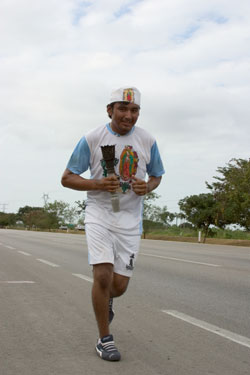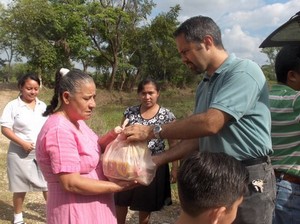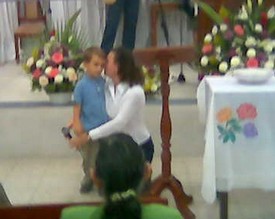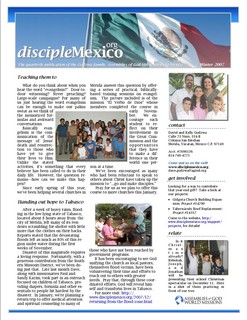This is the first in a series of evangelism training classes to be held in Opichén, Yucatan
You are currently browsing Dave’s articles.
With the close of the year comes the barrage of top fives, tens, twenties… and while most of the lists are the best of (insert item here). I thought that you’d might enjoy another look at some of our favorite posts over the last year. They may not be the most popular, but they’re definitely worth another look:
In the personal reflection category among my favorites are:
 Oh the Humanity: This personal reflection on the mystery of God’s involvement with our humanness came through a time of prolonged sickness. It’s words continue to ring true especially during this season as we celebrate the incarnation of our Lord.
Oh the Humanity: This personal reflection on the mystery of God’s involvement with our humanness came through a time of prolonged sickness. It’s words continue to ring true especially during this season as we celebrate the incarnation of our Lord.
 Topes: With insight into Mexican culture, and cross-cultural ministry in general, this post reminds me that God is in control.
Topes: With insight into Mexican culture, and cross-cultural ministry in general, this post reminds me that God is in control.
From the out of the ordinary category I would have to note:
 A Visit From the Tooth Mouse: This tongue-in-cheek post presents the Latin alternative to the tooth fairy as well as some of the difficulties we face as we live in the city of Mérida.
A Visit From the Tooth Mouse: This tongue-in-cheek post presents the Latin alternative to the tooth fairy as well as some of the difficulties we face as we live in the city of Mérida.
 Coincidence or Confirmation: This post takes you through some of the “coincidences” that we’ve experienced in the journey to the mission field.
Coincidence or Confirmation: This post takes you through some of the “coincidences” that we’ve experienced in the journey to the mission field.
In the final missions category three of my favorites include:
 Conversations: is a reflection on what missions means to this missionary. It’s received a bit of attention, and I hope that it serves to help us, as Byron Klaus says: “Keep the main thing the main thing.”
Conversations: is a reflection on what missions means to this missionary. It’s received a bit of attention, and I hope that it serves to help us, as Byron Klaus says: “Keep the main thing the main thing.”
 Dia de la Virgen and Our Missionary Methods: just happens to be one of my latest offerings. It’s a wondering post, asking questions and providing little in the way of answers, but more than that, it’s an invitation to open discussion about what we’ve done and what we should plan to do as missionaries.
Dia de la Virgen and Our Missionary Methods: just happens to be one of my latest offerings. It’s a wondering post, asking questions and providing little in the way of answers, but more than that, it’s an invitation to open discussion about what we’ve done and what we should plan to do as missionaries.
 Back with a Story to Tell: is the first in a series of posts that details, day-by-day, the impact of a short term missions trip.
Back with a Story to Tell: is the first in a series of posts that details, day-by-day, the impact of a short term missions trip.
We hope these posts will serve as a representative look back on our year in ministry, while they inspire you to dream, pray, and get involved in what God is doing in you, in your community, and in the world.
Prospero Año Nuevo!
Tags: Missions, Reflection, Year end review
 We were driving back from a planning meeting in Muna last Tuesday, where we’ll be hosting my brother and his Chi Alpha team, when I noticed, all along the roadway, bikers, runners with torches, and support vehicles flashing their lights and honking their horns. There were hundreds of people in the hour long stretch that we traveled.
We were driving back from a planning meeting in Muna last Tuesday, where we’ll be hosting my brother and his Chi Alpha team, when I noticed, all along the roadway, bikers, runners with torches, and support vehicles flashing their lights and honking their horns. There were hundreds of people in the hour long stretch that we traveled.
It resembled some kind of Olympic procession. It was as if this group was ushering in the torch to light the first ever Yucatan Games, but looking closer I noticed that each one was wearing a t-shirt displaying the symbol of Mexican religious devotion, image of the Virgin of Guadalupe.
Researching further, I learned from YucatanLiving.com that these “antorchistas” are youth that have made a personal vow to the Virgin, and last week on December 12th, the Day of the Virgin, they ran or biked in order to complete their vow. The trek is a point to point journey, with more favor bestowed for greater distances. Apparently, the bicycle was introduced as a way for the working devotee to cover more ground in a shorter amount of time. (Read fewer days off from the job.)
Of course, we have the tendency to dismiss all of this as a misguided devotion, a practice to abandon as pure paganism. Still, one has to admire the determination, the organization, and the passion of those who would exert themselves for their faith. We evangelicals, a group lacking the presence of young men in our congregations, can’t help but ask, “How do we instill this type of enthusiasm, this type of devotion in our faithful?”
I would suggest that the answer lies within the pages of the Bible in the example of our Lord. It would seem that we are more famous for what we don’t do (drinking, smoking, dancing) than for what we do, for what we are against, than what we are for, but Jesus didn’t seem to be this way. “This man welcomes sinners and eats with them,” was the complaint of the Pharisees and scribes. What I see from Jesus isn’t a prohibition type religion. I see a radical redefinition of religious and social symbols.
To Peter and Andrew, fishermen by trade, Jesus says follow me, and I’ll make you fishers of men. To the woman at the well, Jesus says I am the one who gives living water. At the Last Supper, Jesus redefines the traditional passing of the cup and bread during the Passover meal into a remembrance of his sacrifice on the cross and celebration of the unity that we now have in the Church, the body of Christ on the earth. In other words, Jesus doesn’t seem to separate a person from his or her culture, rather he transforms the culture in much the same way that he transforms the individual.
This to me says that we as missionaries have a need for wisdom and God-given creativity when it comes to engaging a culture. What is truly anti-Christian, and what is simply an expression of culture? How can we contextualize, not just the presentation of the message of the gospel, but also its expression in worship and everyday life?
One case in point of an interesting attempt to accomplish this redemption of culture was in the Chota Valley, a culture of Ecuadorians of African descent. This people group had a dance that utilized a bottle, worn on the head and, if I remember correctly, filled with alcohol. In the bottle would be placed items that represented the pain and suffering that the person experienced in life. Missionary Joe Castleberry and his team, instead of prohibiting this cultural expression, redefined it. Gone was the alcohol and in the place of the symbols of pain and suffering was a flower to represent the new life the Christ brings.
I’ve not had the opportunity to see the “Freedom Valley” project first-hand, but I feel that it touches on an area that all missionaries need to consider. Did we do a disservice in our clothes-line style holiness of the 1900s? Have we relegated ourselves to the fringes of society though our lists of rules and prohibitions? How does it come across in the 21st century? On the flip-side, how does this redefinition of culture look, in Africa, in Mexico, in the US? Also, how do we know that we are truly redefining culture and not just compromising for convenience?
Granted, this task is not something that a simple post can solve, nor the work of one individual, but I think discussion is necessary and helpful if we are truly seeking to change the world.
Note: Picture was taken from YucatanLiving.com. (It’s kind of hard to drive and take pictures at the same time.)
Tags: Antorchistas, cross-cultural ministry, Dia de la Virgen de Guadalupe, Missions
 We’ve returned from our 3 day trip to Tabasco, the region of Mexico that had experienced devastating floods in late October through early November. We loaded up two SUV loads of toys, vitamins, diapers, and powdered milk and drove the 8 hours from Mérida, Yucatán to Villahermosa, Tabasco to bring relief to families, especially those with small children.
We’ve returned from our 3 day trip to Tabasco, the region of Mexico that had experienced devastating floods in late October through early November. We loaded up two SUV loads of toys, vitamins, diapers, and powdered milk and drove the 8 hours from Mérida, Yucatán to Villahermosa, Tabasco to bring relief to families, especially those with small children.
Entering the city, we found that life had returned to its hectic pace with people and cars everywhere. The only visible remains of the inundation was the construction taking place to repair and clean roads affected by the floodwaters. Still, the stories we heard were incredible. People told us that many had remained in their homes, thinking this to be just a routine occurrence during the Tabasco rainy season, but that, as the floodwaters rose, they found themselves waiting on rooftops for helicopter rescue. The pastor’s home where we stayed took on more than 5 feet of water. He and his family stayed in the upper level and were able to save the majority of their appliances and furniture, but mold on the walls and ruined tile floors spoke of the work ahead to restore what the flood had ruined.
The countryside surrounding the city was a different story as floodwater remained on the roads and in the low lying areas that surrounded the houses. While no longer threating homes and schools, the stagnant water poses a health threat especially to the small children who choose to play in the contaminated pools and through mosquito borne illnesses. This is where we focused our efforts.
Entering Tabasco on Thursday night, we pooled together with Pastor Ruben, his family and several members of the church to put together relief packages with food, vitamins, diapers, milk and other essentials for the residents of these needy areas. It was touching to see the desire of these people, who were themselves victims, giving of their time and effort to help those who had needs greater than their own.
The following day, we handed out the supplies and toys to the children and their parents. It was for them clearly a “big deal” as at one point we were accompanied by one of their local government representatives. We were given complete access, even the ability to interrupt the activities of a elementary school to meet with the students.
Food was distributed, toys were given away, and much needed supplies were handed out, but something much bigger was accomplished. These victims received a much needed infusion of hope. They received it realizing that they were not alone in their struggle.
There is something amazing in the fact that God touches people to go and share his love with those who most need to experience it. At one point in the distribution, Paul Kazim, a fellow missionary, prayed. I think it was then that the reality of what we were doing came into focus: Jesus ministered to the people in Mark 6:30-44. He did that even though he was experiencing the loss of his cousin and herald, John the Baptist. He did it because he had compassion. In Tabasco, fellow citizens were putting their lives on hold, lives that had themselves been completely changed by the floods, to reach out to those with greater needs. What was the reason? I believe it to be nothing less than the same compassion that Christ portrayed to the 5,000 that were fed in the Galilean countryside.
We’re planning to go back to Tabasco January 10-13 to provide medical treatment and spiritual counseling to the needy suffering in Tabasco, to the people now being overlooked as efforts are being made to restore a sense of normalcy in the region. We as missionaries will take part, but I think the most effective counselors will be those who have lived through these floods. Those who, because of the compassion that only God can provide, have thought of others as better than themselves.
(You can see more of our recent trip by clicking on the picture above or through this link.)
Tags: compassion, flood, Tabasco
We’re on our way for a three-day relief trip to Tabasco with no time to type. What could be a faster way to relay the story? How about a video blog? Take a look at this latest offering and please remember to pray for those affected by the flood in Tabasco.
 About two weeks ago, (yes, the events of our lives and ministry have taken a toll on my blogging) we celebrated the birthday of our youngest, Jonathan. It was filled with parties–one at school and another here at the house, as well as a mountain of presents, many of which have already made their way to the black hole that our boys call their closet. Of course, all of these things came as no surprise. After celebrating the 19 kids’ parties that we have, from Princess to Bob the Builder to Spider Man to Jungle themes, we’ve come to expect the anticipation, celebration, and sugar withdrawal cycle that each party brings. However, after all of the celebration was over, and Jonathan had time to reflect, he did something unexpected: he decided to testify. In fact it was such a surprise that we didn’t have our camera. The blurry picture was taken with my cell phone.
About two weeks ago, (yes, the events of our lives and ministry have taken a toll on my blogging) we celebrated the birthday of our youngest, Jonathan. It was filled with parties–one at school and another here at the house, as well as a mountain of presents, many of which have already made their way to the black hole that our boys call their closet. Of course, all of these things came as no surprise. After celebrating the 19 kids’ parties that we have, from Princess to Bob the Builder to Spider Man to Jungle themes, we’ve come to expect the anticipation, celebration, and sugar withdrawal cycle that each party brings. However, after all of the celebration was over, and Jonathan had time to reflect, he did something unexpected: he decided to testify. In fact it was such a surprise that we didn’t have our camera. The blurry picture was taken with my cell phone.
Now, I know what you’re thinking, testimony night has gone the way of Sunday morning prayer requests in most churches, they’re just not done, but here in Mexico, testimony night is alive and well, and two weeks ago last Sunday a certain recently turned 5 year-old decided to step forward and thank God for another year that God had allowed him to complete.* Not only did he testify, he also sang “Open the Eyes of My Heart” (“Abre mis Ojos, Oh Cristo”) in Spanish.
To me, this is the sign of two things happening:
- that our son is rapidly acculturating: Testifying is expected of church members when they celebrate their birthday. That Jonathan noticed this and wanted to do it tells me that he’s becoming more “Mexican.”
- that our son is recognizing God as part of his life: It was hard for me to choke back the tears as I listened to our “baby” asking Jesus to help him to truly see Him as he is. It’s my desire as a father to be a part of the the answer to that prayer.
*Spanish idea: We don’t “turn” years old as we celebrate birthdays, we complete years or “cumplemos años” hence the Spanish salutation “Feliz Cumpleaños”
This is the third in a series of evangelism training classes to be held at Cristo, la Esperanza in Mérida, Yucatan
Trip to Tabasco to help relief efforts for flood victims
This is the beginning of the new bimester at Bethel Bible Institute in Mérida, Yucatán. Dave will be teaching the course Practical Evangelism to first-year students.





